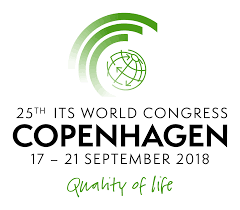The ITS (Intelligent Transport Systems) World Congress is a pretty big deal in the public transport world. The 2018 Congress has just been held in Copenhagen and I was excited to attend to present a paper that I had accepted and to take part in this global discussion about the future of transport.
There has been a perceivable change in the themes covered in the ITS Congress’ sessions over recent years, reflecting a wider industry shift towards ‘mobility’ and ‘service’ instead of ‘transport’, ‘vehicles’ and ‘operations’. With the theme of this year’s Congress being ‘Quality of Life’, a citizen-centric approach was apparent across many of the presentations I attended.
Mobility as a Service (MaaS) is a hot topic at the moment and is an area I am actively engaged in. At its most simple I would describe MaaS as an approach to reduce single-occupancy car use by making it much easier for people to be aware of, and combine, a mix of alternative modes, which together can match the car for ease and convenience. It was impressive to see so many session dedicated to, or including discussion of, MaaS and while not everyone is in agreement about the approach to delivering MaaS, the conversations are definitely moving forward. However, it wasn’t strictly a MaaS presentation that has stuck most firmly in my mind.
The very last session I attended, was one I selected on the spur of the moment, but I’m very glad I spotted it on the Programme. It was called ‘Better Mobility with Public Transport’ and included three excellent presentations about activities being undertaken by HSL (the Helsinki Region Transport Authority), Ruter (the public transport authority for Oslo and Akershus counties) and Movia (the Greater Copenhagen public transport authority). These agencies have been supporting each other in refining their direction and approach to public transport delivery.
It was a story from Endre Angelvik at Ruter, which really caught my attention although all were clearly undertaking some excellent work. Endre talked about their desire to reduce single-occupancy car use, but instead of being caught up in MaaS or another technical solution, they’d had taken a broader approach. They’d noted that trip chaining (i.e. stopping at multiple points along your journey for different tasks such as picking up some shopping on your way home from work) was actually one of the biggest challenges to reducing car use in their Region. At the same time, they had some issues to solve around the transportation of children to after-school activities and then to their homes afterwards. By putting on a relatively simple minibus service, which the kids paid for using a usual child’s monthly travel pass, they quickly solved the problem of getting them home. It also boosted inclusion for children whose parents may not have otherwise been able to get them to/from these activities. However, the even greater knock-on effect is that the kids’ service removed the main chain in the evening commutes of the parents. This meant more parents could leave their cars at home that day and take public transport.
In some ways, this all seems so simple and commonsensical. However, this type of approach doesn’t happen often enough. All too often we get caught up in finding a technological fix, and miss the wider opportunities. I found it inspiring to listen to Endre and his Nordic colleagues and am sure I will now question our transport challenges and solutions even more thoroughly.

1 reply on “Nordic ideas from the ITS World Congress 2018”
Sounds very sensible. School run makes is a challenge for so many as not all kids live in a walkable distance from school. Good to see lateral thinking here.